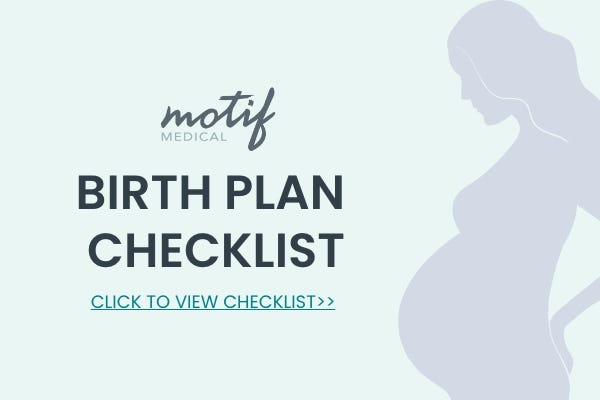NEW Motif Birth Plan Template
There is nothing else in life that can be compared to childbirth. Birth is unpredictable, and almost always goes differently than you envision, and while your body is doing all of the work, it is largely outside of your control. Birth is physical, yes, but it is also a mental, emotional, and spiritual process that happens as you meet your new baby. Put simply, a lot is going on when you give birth! And while so much is happening, there isn’t a lot of time or energy for you to use making important decisions about the care you want during birth. That’s why I think it’s so important to make a birth plan when you’re in the third trimester.
Or as I prefer to call it a list of birth preferences—because you really can’t “plan” birth. In any case, taking the time to walk through the options that might be presented to you while you’re in labor is going to help you feel more confident and prepared and it will also enable you to make informed decisions throughout the process. Using a birth plan template is particularly helpful because people who work in the birth setting every day know the topics that frequently come up in the delivery room. This means that they can point you to the most important questions that you’ll want to research and decide on before the big day!
Thankfully, Motif Medical has put together a new downloadable Birth Plan Template that you can print, fill out, and take with you. Let me walk you through what it includes.
Beginning Your Birth Chart
Aside from some basic contact information about yourself, at the top of the birth plan template, there is a place for you to let your healthcare team know to whom you want them to direct any questions. Whether you are planning to birth in the hospital, a birthing center, or at home your providers will have a list of questions they’ll need to ask you as part of your initial labor assessment.
If you are having regular contractions, these questions can disrupt your focus and make it more difficult to manage the intensity of the birthing surges. You and your birth partner, doula, or other family members can decide ahead of time if you want someone else to be able to speak for you. This can keep communication flowing between you all without distracting you from the work of labor.
Understanding Your Birth Plan
Support System
The next thing you’ll want to cover on your birth plan is who you are planning to bring with you for support. You’ll want to list their names and what their role is going to be on your birth team. If you are going to have a doula, midwife, or other support person, let your care team know. They also want to be informed if you’ve hired a birth photographer. Some birthing locations have rules about what can or can’t be photographed during delivery, so they’ll want to know who to talk to about that. This simple step lets everyone be on the same page about who to expect and how they will be supporting you during the birth.
Equipment
If you want to have access to any particular equipment while you are at the hospital or birthing center, go ahead and list that on your birth plan. You can designate a member of your birth team to either pack these items in your car or help locate them when you arrive at your planned birthing location.
Sometimes items can take a while to track down, so if you get everything assembled when you first arrive you will have the tools you want when you’re ready to use them.
Some hospitals only have birthing tubs in certain rooms, so make sure someone is in charge of getting you to the room you want to use, especially if you want a water birth! Even if you don’t intend to use it right away, go ahead and ask your nurse or provider for a birth ball, peanut ball, squat bar, or any other equipment you may want to use during labor.
Environmental Settings
Let your care team know about the environment you want to create for your birth—do you want special lighting? Do you plan to use a diffuser for aromatherapy or play music? Are you going to wear your own clothes or would you prefer a hospital gown? If you choose to wear your clothing, I recommend looking into the labor gowns that you can purchase online. Hospital gowns are convenient for IV access, they unbutton at the shoulders to make breastfeeding easier, and they open at the back, in case you choose to get an epidural. These are all situations when your provider will want the flexibility provided by a hospital gown or one of the labor gowns you can buy.
Your Due Date Options
As part of your birth plan, you want to think through the options and choices that may come up during your birth. You can list your preference for the type of birth you’re planning for vaginal birth or a cesarean birth. Let your provider know how you feel about pain medication options. You’ll also want to think about whether you want your providers to suggest pain medication along the way or not. As your labor pains increase, it is common for nurses to want to help and their go-to source for pain relief is pain medication.


But if you want to have a birth without using medication for pain management, you may not want them to do that because the power of suggestion is strong and might make you feel like you aren’t doing a good job, even if you are. You’ll also want to know your thoughts on labor augmentation with Pitocin. Even if you don’t plan to be induced, this topic could come up during labor. Do you have preferences for fetal monitoring? What are your thoughts about internal fetal monitoring, artificial rupture of membranes, and other birth interventions such as using forceps or a vacuum? List all of these things on your birth preferences sheet so that your healthcare provider will know.
During Labor
Once you’ve covered the topics that might come up during labor, it’s time to shift your focus to the moment of your baby’s birth. Who do you want to catch your baby? Do you want to use a particular birth position? Is there a position you don’t want to be in when you give birth? How do you feel about an episiotomy? Do you plan to practice delayed cord clamping? If so, how long do you want to wait before they clamp and cut the umbilical cord? If you are planning to do cord blood banking, please factor this into your preferences because the cord blood has to be collected soon after birth. Are you planning to keep your placenta? If so, you’ll want to bring a cooler so it can stay chilled until you take it home.
Next, figure out what your preferences are for “the golden hour.” The Golden Hour is the first hour after birth and having the baby skin-to-skin with you during this time is beneficial for both the birthing person and the baby. Some people prefer to have their babies cleaned up a little bit before they hold them, so let your doctor or midwife know if you have a preference. Also, think about when you want to have the newborn procedures done. These include newborn weight, measurements, Vitamin K, erythromycin eye ointment, and Hepatitis B vaccine administration. You can choose to have these given immediately or you can delay for an hour so you and your baby can spend the golden hour together.
Game Plan 101: Healthcare Providers
Lastly, let your healthcare team know about your preferences for feeding and caring for your baby. Do you plan to breastfeed or bottle feed? Do you want your little one to “room in” with you, which means your baby will not leave your room, or do you want the nurse to take your baby to the nursery sometimes?
Your overall birth experience will be influenced by how your labor starts and other things that are outside of your control, but remember that no matter what’s going on, you always have choices. The point of creating a birth plan is to educate yourself about those options ahead of time. This is a crucial step for having a positive birth experience because as they say in the birth world, “If you don’t know your options, you don’t have any.” -Diane Korte
Information provided in blogs should not be used as a substitute for medical care or consultation.











